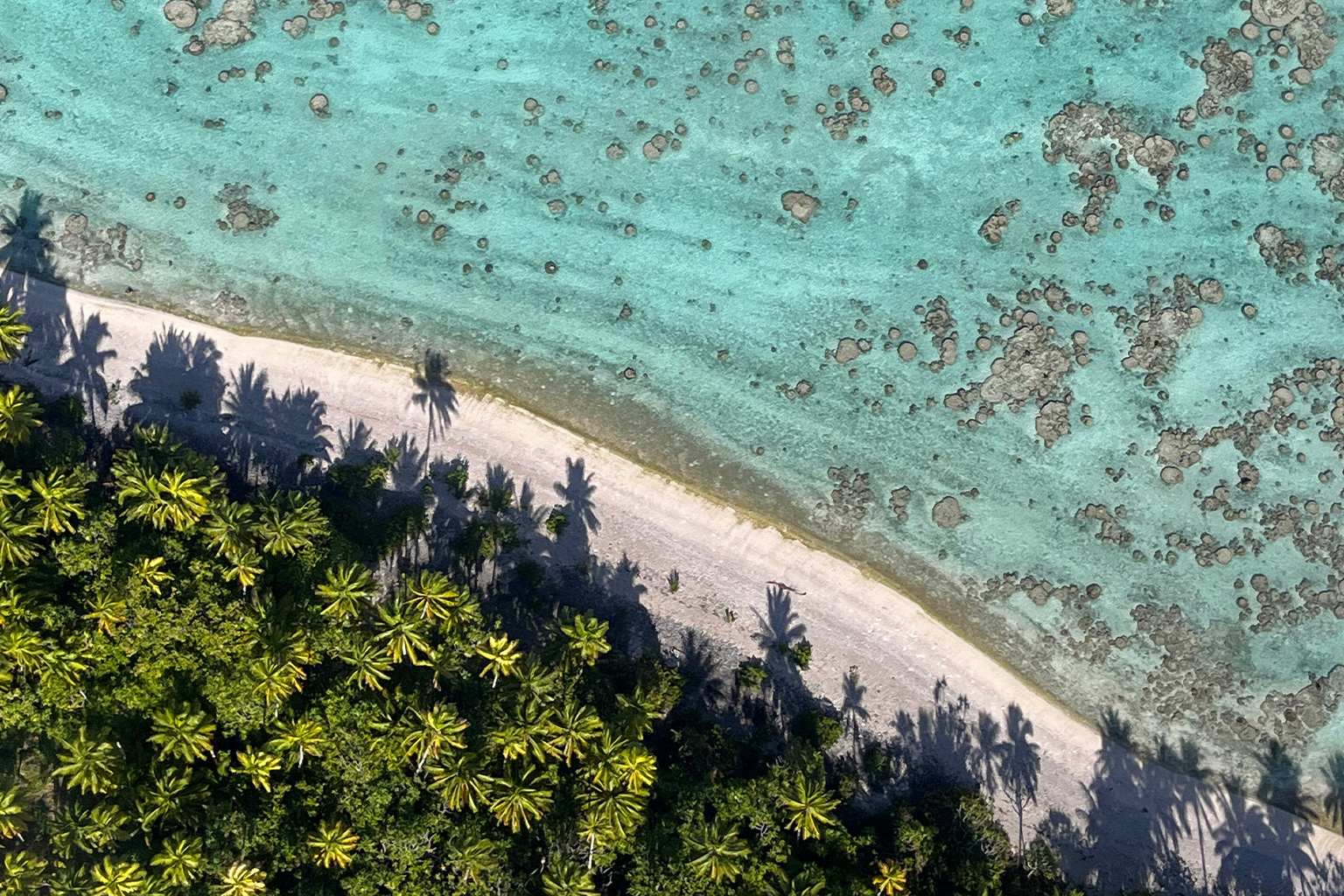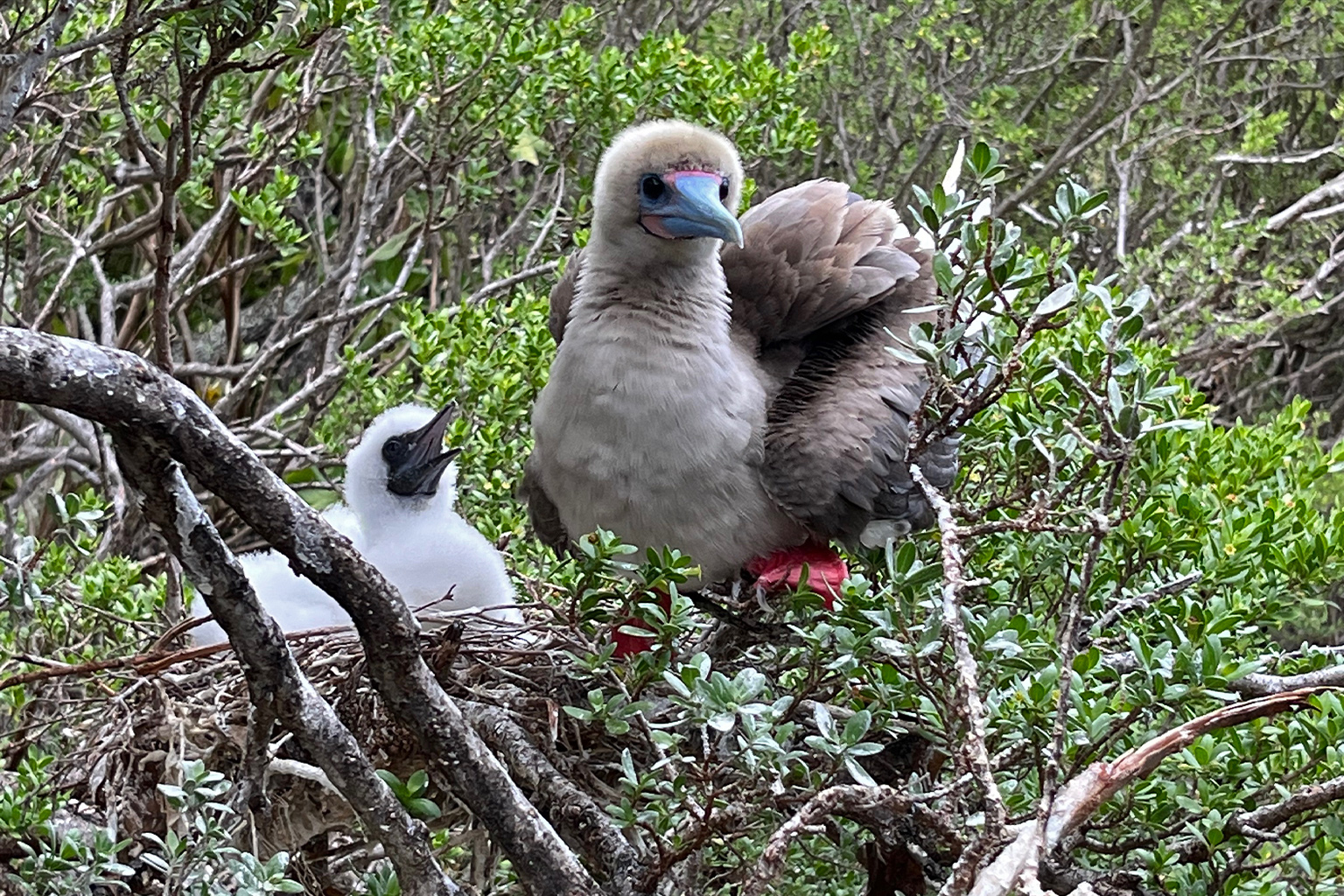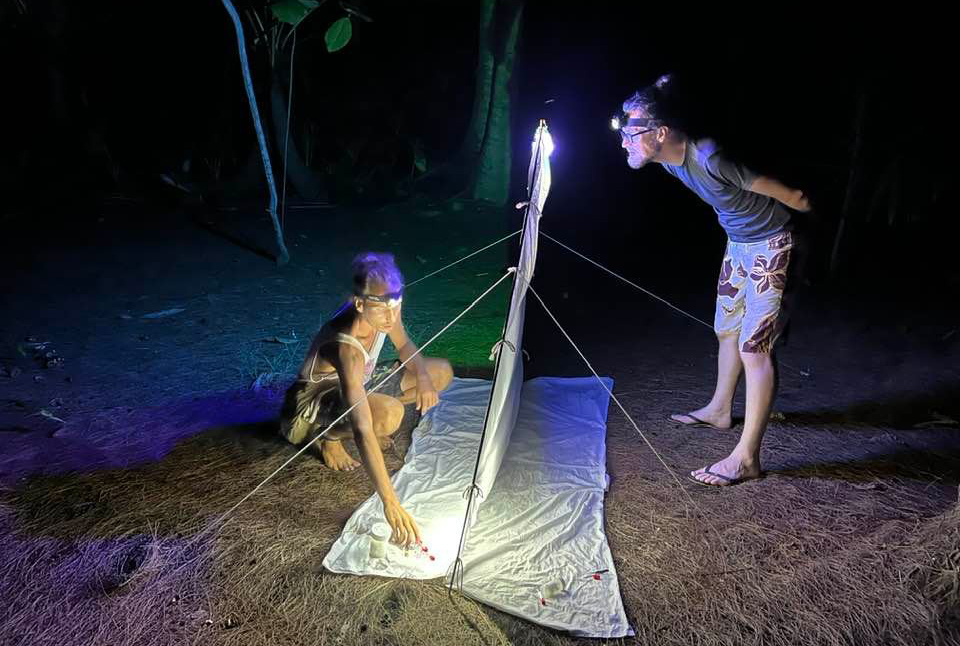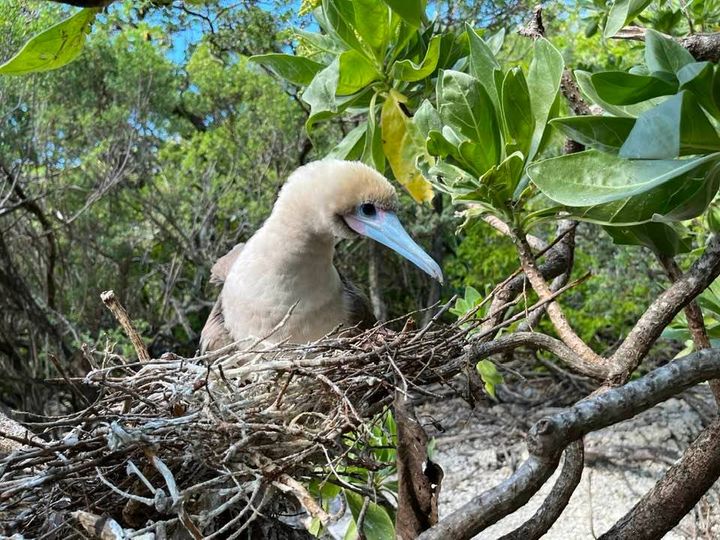- Like many islands around the world, Tetiaroa Atoll in French Polynesia has been overrun by rats and other invasive species that profoundly affect its terrestrial and marine ecosystems.
- In July, the paradisiacal 12-island atoll was declared rat-free after years of concerted efforts to wipe out the predators.
- Scientists have been studying the atoll’s plants, seabirds, insects, lizards, crabs, coral and algae, establishing a uniquely comprehensive ecological baseline to better understand how the rat eradication will affect the atoll — and others like it.
The black-and-white motion-triggered video looks like an outtake from a cheap horror movie: A handful of rats circle a smooth, platter-sized mound of sand. Suddenly a sea turtle hatchling appears, digging out of the nest. A rat grabs it by its head and quickly drags it off-camera. A second hatchling is snatched by another rat, flipped on its back and dragged off. The video ends.
But there’s more. In 2007 the first yellow crazy ants (Anoplolepis gracilipes) were identified on one of the same islands, or motus, of Tetiaroa Atoll in French Polynesia. There are some 200 species of ants in Polynesia, all nonnative, but the yellow crazies are the worst. “They spray formic acid that can blind or else deform the wings and legs of seabirds,” says Jayna DeVore, one of the scientists working out of the Tetiaroa Society’s eco-station on the main resort island of Onetahi. “I’ve seen chicks dancing in their nests to get the ants off them.”
DeVore extends a collapsible pole with a GoPro camera atop it to peek into a nest high up a mikimiki tree (Coprosma linariifolia). She’s looking to see if there’s a chick in it. The red-footed booby (Sula sula) parent flaps its wings and pokes at the camera with its long blue beak. Dozens more boobies and frigatebirds (genus Fregata) circle in the cerulean blue sky and occupy nearby trees and bushes in the seabird colony we’ve waded and hiked to on Hiraanae motu. Her seabird ecology study, along with those of other scientists researching the atoll’s plants, insects, lizards, crabs, coral and algae may be unique to the world.

“It’s a fantastic opportunity to study an ecosystem before and after an apex predator impacts it,” says Sebastian Steibl, an atoll ecologist at the University of Auckland who leads the insect study during my visit in May 2022. “Right now we’re building the first complete pre-eradication baseline that anyone knows of.
“To date, all the studies have been analogies, comparing islands with or without an invasive species, but ecology is more messy and complex than that,” he adds. “For example, rat eradication on land will definitely cascade into the marine environment.”
When in 1995 Yellowstone National Park in the U.S. reintroduced a top predator that humans had eradicated — the wolf — it profoundly affected our understanding of ecosystem recovery. How the eradication of a top predator introduced by humans — the rat — will alter a very different ecosystem may help define the next chapter in conservation science.
When people talk about invasive species they’re talking about the spread of nonnative plants, insects and animals, such as cane toads and rabbits in Australia, boll weevils, zebra mussels and kudzu vine in the U.S. and lionfish in the Caribbean. Their impact is both ecological and economic. A 2021 study found invasive species cost the U.S. $21 billion a year. Global costs, including from agricultural pests, have been estimated at $1.28 trillion or about 5% of the world’s GDP over the last 50 years.
Among the oldest and most destructive invasive animals, particularly for island ecosystems, are rats. The Polynesian rat (Rattus exulans) colonized the Pacific by stowing away on the earliest navigators’ voyaging canoes more than 2,000 years ago. The black rat (R. rattus) arrived with Captain James Cook and other European sailors around 250 years ago. On Tetiaroa rats have been found on nine of the atoll’s 12 motus. Though interrupted for two years by the COVID-19 pandemic when most scientific and resort operations were shut down, the eradication program was successfully renewed so that Tetiaroa became rat-free in July 2022, several months after the visit described here. It should be free of yellow crazy ants, likely introduced by supply boats, in November 2022.

A picture-perfect vision of a tropical paradise with a wide, elegant ring of green islands around a teal and aquamarine lagoon surrounded by darker blue seas, Tetiaroa, located 30 nautical miles (56 kilometers) north of Tahiti, was once the summer retreat of Polynesian royalty. It was bought by actor Marlon Brando (under a 99-year lease) in the late 1960s and today is home to the Pacific Beachcomber Group’s resort, The Brando, one of the world’s most exclusive (read expensive) retreats. This is reportedly where Barack Obama began work on his post-presidential memoir, and billionaires and celebrities such as Leonardo DiCaprio and Kim Kardashian have shared crystal clear waters with blacktip (Carcharhinus limbatus) and lemon sharks (Negaprion brevirostris). Sea turtles nest under some of the guests’ beachfront villas.
“With the resort closed during COVID we were able to flag and treat this island,” says Baudouin des Monstiers, the trim, lightly bearded project manager for the rat eradication, referring to Onetahi. He points out various orange ribbons on trees and stakes every 20 meters (66 feet) that mark the transects or grids that prepared the way for ground crews to disperse two treatments of rat poison baits 21 days apart and 10 meters out from every flag, so that all vegetation on rat islands gets covered. This would be followed by ant baits.
“It’s all done with compasses, measuring tape and machetes,” des Monstiers says, although the team also uses GPS to confirm the precise location of the 13,000-plus flags they’ve planted across more than 5.2 square kilometers (2 square miles) of island acreage. The atoll itself is more than 6.4 km (4 mi) across.


Des Monstiers works for Island Conservation, a Santa Cruz, California-based nonprofit that seeks to prevent extinctions of highly endangered island species. Tetiaroa’s include various seabirds and sea turtles.
The water-insoluble rat bait the team uses, Brodifacoum, followed by Fipronil for the ants, can be disbursed only between June and August when there are no migratory birds or turtles on the atoll. Other resident species, such as seabirds that only eat fish and crabs with their gelatinous blue blood, are not interested or affected by the anticoagulant baits.
In the afternoon, I join Steibl and Thibault Ramage, a freelance entomologist here to help with some insect collecting techniques, as we thump across the turquoise lagoon in a fast skiff steered by ranger Toni Fioretti. Half an hour later we’re wading onto the coral-debris-strewn shore of Reiono motu, where we’re greeted by a booby and its fluff ball white chick in a heliotrope tree (Heliotropium arboreum) plus large red hermit crabs wearing a stylish assortment of shells. Steibl points out a tupa crab (Cardisoma carnifex) that the locals eat after feeding it coconut or banana to amend its otherwise muddy taste.
We enter into the surprisingly open and light-filtered green enchantment of the interior forest. “It’s a natural atoll forest,” Steibl says quietly. Cabbage trees (Cordyline australis), some thick as banyans, share common root clusters and multiple stalks, as they rise 15 meters (49 feet) and more into the shade canopy. Rats were eliminated on this motu in 2018 and the ground is now covered with rotting coconuts sprouting saplings a meter tall or more. Coconut palms (Cocos nucifera) are also nonnative to Polynesia, introduced for plantation production. “We’re restoring an ecosystem whose pristine state we don’t even know what it looks like,” Steibl says.


We stop at a white-splotched tree. “Let’s look for one with less guano,” Ramage suggests. We see our first large coconut crab (Birgus latro) hanging at the entrance to its big burrow at the foot of a cabbage tree. Soon a second smaller one, about the size of a Nerf football, scurries away from us through the foliage. They’re endangered elsewhere but common on this island with its restricted access. Since rats were eliminated, Reiono has also become one of only two black noddy tern (Anous minutus) breeding colonies in this part of Polynesia. Oddly, the other is in a traffic roundabout on Tahiti.
Ramage unfolds a wide white square with tent pole-like supports and shakes a tree to catch ants and a tiny spider that fall from it. He and Steibl sample the results with tweezers, placing unusual specimens in small, red-capped vials of ethanol. Loud bird calls echo through the forest. He spots and identifies a tiny jumping spider (family Salticidae) and a micro-ant. “Takes a trained eye. I started when I was 3,” Ramage says. He then finds and collects a pseudoscorpion (order Pseudoscorpiones) and two real ones, both tiny enough to fit into his vials.
Asked if there have been other studies of rat-impacted tropical islands as granular as this one, Steibl says, “It’s been done on Palmyra, but not with this level of before and after attention.”

Rats first arrived on Palmyra Island, an isolated U.S. possession 870 nm (1,600 km) south of Hawaii, with the U.S. military in World War II. Conservationists killed off 40,000 of them in 2011. In the following decade new plant seedlings increased fourteenfold (rats eat a lot of seeds), but they’re mostly coconut palms that outcompete native plants. The good news is that invasive tiger mosquitoes (Aedes albopictus) also disappeared with the rats (not enough mammal blood to feed on), two native species of crabs reappeared and the seabird population is growing.
A 2018 study in the Chagos Archipelago in the Indian Ocean found rat-free islands have significantly more seabirds (sometimes 10 times as many) as rat-occupied islands and thus more seabird guano that both enriches their soils and runs off onto the coral reefs.
This natural fertilization seems to make the coral more resilient to climate change and also attracts more herbivores, including parrotfish (family Scaridae). Fun fact: Some large parrotfish will eat algae-covered coral rock and poop out up to 450 kilograms (roughly 1,000 pounds) of sand a year, helping create most of those white sand tropical beaches people find so attractive.
Later that evening, back on the resort island, Steibl and Ramage set up a light trap, a half-moon of material (under an actual half-moon) staked to the ground with a bluish ultraviolet light at its top to attract pollinator moths.
Before collecting the moths, Ramage illuminates one of the scorpions from Reiono with UV to show how it glows a florescent lime green. Turns out the scorpions and cockroaches on the atoll also reproduce asexually. “It was challenging enough getting here so they can’t expect to find a mate,” Steibl says somewhat defensively before being interrupted by the crack and potential head smash of a falling coconut. The scorpion scurries off into the rough. Apparently, a three-hour alcohol bath is just a spa treatment for the tough little critter.

Back at the eco-station, an open-air birthday party is taking place for one of the 20 mostly Tahitian members of the rat team, just returned from five days on Tiaraunu, the largest and, as it turns out, toughest of the motus. Beer, rum, Cokes and conversation are shared beneath the palm fronds of a star-spangled sky.
“I’m very proud of the team,” des Monstiers says. “Everyone was cutting trail from 8 a.m. to 9 p.m. with lots of machete work. It’s been the most dense vegetation to date, with the rats eating our flags and boxes and tape and always trying to damage the work. They’d get in the tents, climbing around along with the land crabs. Some rats ate my plastic shoes and ate through Tupperware to try and get to our food. We also had one guy we had to evacuate by boat. He had chills and fever and it turned out it wasn’t the [COVID] virus. We don’t know what it is yet. We also got some infections from the spines of sea lettuce and panda [pandanus] bush.”
“There were many rats but also a few birds that are nice to see,” says Lisa Wauters, a team member with a corona of red curls who has just taken her first shower in a week. “The rats are tricky. They peed all around our camp and on our food plates that we had to wash then. But we have a good team so we have a good time despite it all.”
A large man with a white beard sits down beside me and tells me how he guides guests fly-fishing, except the bonefish (Albula glossodonta) just want to be left alone right now. Teihotu Brando, one of the actor’s sons, goes on to talk about his love of bonefish and the seabirds and nature and how we’ve gotten it all in trouble with our “geo-engineering,” but he trusts the scientists who come to work on his island.
I’m dropped off at Hiraanae motu the next day where DeVore and her co-researcher (and husband) Simon Ducatez have been camping for three days, studying seabirds and ghost crabs (subfamily Ocypodinae). We watch a couple of blacktip sharks cruise by in the clear shallows. Ducatez works for the University of French Polynesia and DeVore for the University of Washington. DeVore is also program coordinator for the Tetiaroa Society, which was established by the resort’s developer and eco-entrepreneur Richard Bailey, a longtime friend of Marlon Brando’s who shared an early vision for protecting the atoll.

DeVore talks about a live rat Ducatez had to poke out of his gear bag and a dead one, cause of death unknown, under their tent that is now lying in the nearby sand. “That got worse and worse smelling,” she smiles. “Still, at night with the birds screeching and all the other sounds in the forest it’s like Jurassic Park here.”
She then picks up a small ghost crab with white claws. “They’re shy and stay close to their burrow entrances on this island because the rats go after them. On [rat-free] Honuea we found them all over the beach and they were much easier to catch and count,” she says. She and Ducatez count and study crab behavior by adding superglue to small numbered stickers that they attach to the shells, sealing them with clear nail polish. She releases the crab and it makes a surprisingly fast dash to the water.
I spend the next few hours studying researcher behavior as DeVore surveys the birdlife, recording data on her cell phone. “M 3-F I’m recording at 9:34”: the booby stares at her then looks away. “A 15-2, 9:58 recorded by me”: a handsome disinterested frigatebird. A big bird splat just misses us. I look up a tree at the red feet of the bird. “Some rats can climb trees but with the ground nesters you have the most trouble,” she says. “With brown boobies, you can see the rats just rolling the eggs away.”
With hundreds of birds circling, we make our way back across razor-sharp coral rock and an interior island trail to the beach where the camping gear is now sorted and ready to go. A couple of resort guests kayak around a neighboring island near a waiting pontoon boat. Soon the ranger boat arrives with Steibl and Ramage aboard. We begin loading the gear when they spot the dead rat, now covered in flies. They set down their packs and pull out their equipment. “Looks like there’s a wasp feeding on the eye,” Steibl notes excitedly, crouched down by the little corpse. Ramage takes a tweezers and plucks it off the eye and into one of the vials. “Invert [invertebrate] guys sample the weirdest spots,” Jayna says dryly. Conservation field science can be both weird and surprising.

Back on the resort island, Ducatez tells me how two months earlier he was wading calf-high through the shallows off Rimatuu motu looking up for birds when a nearly 2-meter-long (6.6-foot) lemon shark suddenly bit his foot. Luckily, he was wearing thick reef walkers and socks. He kicked it with his other foot and it left him shocked but uninjured. “When I arrived back here, I thought I’d at least have the best story of the day,” he says with a grin, “but one of the guys had just gotten to play music with the lead guitarist for the Eagles.”
I talk to Frank Murphy, executive director of the Tetiaroa Society. The group was founded on Marlon Brando’s promise, quoted on its website, that “the island will serve as an ecological model … as well [as] a place for all manner of scientific research.” Murphy says he believes that beyond its world-class resort status “this small atoll might have a real impact on the planet.”
The late biologist E.O. Wilson and others have argued that ecosystem protection and restoration has to become a major human enterprise in the coming decades if we’re to slow the planet’s sixth extinction pulse we’re now living through. Restoring island ecosystems can help, but it won’t be enough.
“Even with restoration you still worry about climate change because of increased storm intensity and frequency and how that impacts things,” says DeVore. “I’ve seen red foot [booby] nests gone, blown out of trees and as much as a third of brown noddy [ground] nests taken out by big storm waves.”
Cécile Gaspar, director of Te Mana O Te Moana, the turtle rescue center that monitors the sea turtle nests and hatchlings on Tetiaroa, says she’s excited about the rat eradication program, and also happy that her team is still recording a 52% female birth rate on the atoll.
Like many reptiles, sea turtle birth sex is determined by temperature, and in today’s rapidly warming world the ratio has gone badly askew. New turtles hatched on beaches along parts of Australia’s Great Barrier Reef, for example, now turn out 99% female, according to a 2018 study. A more recent study found that half its corals died from climate-linked bleaching between 1995 and 2017.
“I’ve heard people — not well-intentioned, I think — argue we shouldn’t even be doing science on atolls because they’re all going to be gone with sea level rise,” Steibl says. “But there are studies that tell us 85% of atolls will survive till the end of this century. And we’d better be on the way to fixing things by then or …”
He doesn’t finish his thought. He doesn’t have to.
David Helvarg is an author, founder of Blue Frontier, an ocean conservation group, and co-host of the Rising Tide Ocean Podcast.
Correction 11/11/22: An earlier version of this story stated that a lemon shark bit Thibault Ramage’s foot. In fact the shark bit Simon Ducatez. We have corrected the story. We regret the error.
Banner image: Jayna DeVore and Simon Ducatez approaching Hiraanae motu. Image by David Helvarg.
Citations:
Fantle-Lepczyk, J. E., Haubrock, P. J., Kramer, A. M., Cuthbert, R. N., Turbelin, A. J., Crystal-Ornelas, R., … Courchamp, F. (2021). Economic costs of biological invasions in the United States. doi:10.1101/2021.07.02.450757
Zenni, R. D., Essl, F., García-Berthou, E., & McDermott, S. M. (2021). The economic costs of biological invasions around the world. NeoBiota, 67, 1-9. doi:10.3897/neobiota.67.69971
Graham, N. A., Wilson, S. K., Carr, P., Hoey, A. S., Jennings, S., & MacNeil, M. A. (2018). Seabirds enhance coral reef productivity and functioning in the absence of invasive rats. Nature, 559(7713), 250-253. doi:10.1038/s41586-018-0202-3
Jensen, M. P., Allen, C. D., Eguchi, T., Bell, I. P., LaCasella, E. L., Hilton, W. A., … Dutton, P. H. (2018). Environmental warming and feminization of one of the largest sea turtle populations in the world. Current Biology, 28(1), 154-159.e4. doi:10.1016/j.cub.2017.11.057
Dietzel, A., Bode, M., Connolly, S. R., & Hughes, T. P. (2020). Long-term shifts in the colony size structure of coral populations along the Great Barrier Reef. Proceedings of the Royal Society B: Biological Sciences, 287(1936), 20201432. doi:10.1098/rspb.2020.1432
FEEDBACK: Use this form to send a message to the editor of this post. If you want to post a public comment, you can do that at the bottom of the page.
